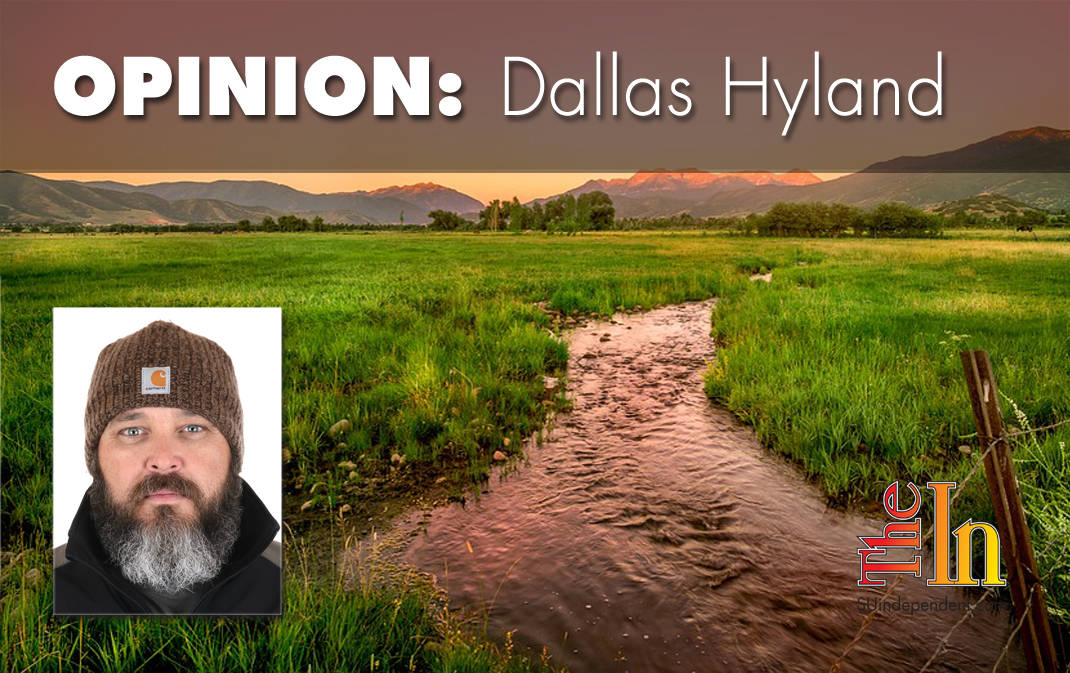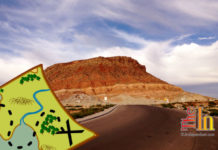 While sitting at a campfire at a friend’s home this last spring, the subject of public lands came up — in particular, the discussion of what the current administration has planned for them. One particularly verbose and self-proclaimed member of the elite “pioneer stock” of Utah seemed a little discontented with the idea that there was even a discussion to be had on the matter.
While sitting at a campfire at a friend’s home this last spring, the subject of public lands came up — in particular, the discussion of what the current administration has planned for them. One particularly verbose and self-proclaimed member of the elite “pioneer stock” of Utah seemed a little discontented with the idea that there was even a discussion to be had on the matter.
“We need to take our damn land back,” He said.
This is a more-than-common sentiment on the topic among conservatives and pseudo-scholarly Constitution lovers. It is espoused as an obvious point of fact and generally accepted to be so with little debate. This is problematic for reasons we’ll discuss, but at the outset here, it is something that very much needs to be understood before taking to the task of preventing states from gaining control of federal lands.
Generalizations duly noted here, it is safe to say that many of the proponents for control of state lands lean toward a fundamentalist conservative worldview. With that in mind, perhaps an analogy of sorts could be drawn from someone they regard highly and authoritative on matters of conscience in an effort to begin a dialogue by first finding some common ground.
C. S. Lewis is perhaps one of the more notable and beloved theologians and advocates of the absoluteness of deity in the eyes of western Christian civilization. He wrote, “Good philosophy must exist, if for no other reason, because bad philosophy needs to be answered.”
By “philosophy,” he presumably meant “theology,” among perhaps other things. But the point is that it was not lost on him that it is imperative to bring an argument upon matters of consequence, as much of the truth in facts as can be mustered at the time, else the argument itself is pointless. And he presumed in this statement that this precept was a universally transcendent one.
When it comes to the debate over public lands at present, and drawing from the example the boisterous Utah native presents, it should be said that an accurate understanding of history and laws regarding public lands must exist, if for no other reason than because inaccurate and ignorant ones must be answered.
And in this time and place in history, it is as important as ever, because, my friends, that inaccurate and ignorant paradigm may well prevail in a manner not thought possible until now.
Public lands, national monuments and parks, state trust lands, and environmental regulations and agencies have prevailed largely under the attacks of such ignorance because no matter what salvos of emotional appeal were lobbed at them, the courts were what they ran up against.
Legislators with ties to the extraction industry would rally causes of federal land being ceded to state control with the ardent support of their constituencies but would invariably only gain the loyalty of their supporters for their attempts. It was the courts that would stop them. Espousing without merit that the states are really the constitutional, legal, rightful owners of U.S. public lands and portraying the ownership of land by the federal government as illegal and unconstitutional, these legislators would spend vast amounts of tax dollars mendaciously pursuing the agenda. And in spite of the failed outcome, which often their own offices of research and legislative councils would advise them of, they would consider it a successful loss. They may not have accomplished the goal, but they satisfied their ill-informed base that they had fought the good fight, often capitalizing on the fact that this very base did not know enough to know that they were being used for a corporate agenda.
It sounds appealing to the average supporter of this agenda that the federal government is out of control and has no right to the land it has taken. To these supporters, the land must be taken back at all costs.
This just simply does not align with facts.
The United States government owns 650 million acres of land. That is about 30 percent of the land area of the country. At one point early in its history, it owned all of the lands west of the original 13 states. Federal land ownership started when the original states ceded their “Western Land claims” in the decade beginning in 1781. Other than these Western lands claims, none of the original public domain was ever owned by states.
These lands cannot be “given back” to the states, because the states never had them in the first place.
U.S. acquisition of federal lands occurred mostly from 1803 to 1867, beginning with the Louisiana Purchase and ending with the purchase of Alaska.
This is covered in the U.S. Constitution by the Property Clause (Article IV, section 3, clause 2), which reads, “The Congress shall have power to dispose of and make all needful Rules and Regulations respecting the Territory or other Property belonging to the United States; and nothing in this Constitution shall be so construed as to Prejudice any Claims of the United States, or of any particular State.”
The Antiquities Act of 1906 followed the 1905 and earlier designations of national forests, and the Federal Land Policy and Management Act of 1976, or FLPMA, is likely the most concrete and impenetrable legislation protecting federal lands. FLPMA repealed all land-disposal claims and made it national policy that from then on the general intent was to keep all the public lands. This is where the law regarding public lands sits today.
Likely in response to FLPMA and perhaps an increasing interest by the general public on a national level to regulate grazing and forestry practices on public lands, the Sagebrush Rebellion of 1976 began. Largely lead by ranchers who in some cases rightly felt their lifestyles and livelihoods were being infringed upon, the rebellion was put down in 1984 by the courts.
But its spirit lives on and can be witnessed in recent upsurges such as the standoff in Bunkerville, Nevada by rancher Cliven Bundy, the illegal ATV ride through Recapture Canyon in southeast Utah spearheaded by San Juan County Commissioner Phil Lyman and inflamed by Bundy’s son Ryan, and the illegal takeover of the Malheur Refuge in Oregon by Ryan and Ammon Bundy and accomplices.
In spite of the radical nature of the Bundys’ misaligned defiance, it is understandable on some levels and to varying degrees represents the unrest and dissatisfaction the west has been accumulating with the federal government. American heritage in the west is all but synonymous with the western rancher/cowboy culture as it embodies the rugged individualism of the American ethos.
And it is that ethos and the ill-informed infatuation with it that groups like the American Legislative Exchange Council, or ALEC, have aligned with to accomplish corporate interests disguised as the interests of everyday Americans with a stake in public lands.
ALEC is a political vehicle of the Koch Brothers for transforming their ideology and policy preferences into law. Extractive industries, such as mining industries and fossil fuels, as well as real estate developers desire federal lands for development without the environmental regulations, fees, and royalties required by federal land management agencies.
And with the recent election of Donald Trump and a powerful Republican majority, the groundwork is now in place for a real and viable threat to public lands once so ardently protected by legislation enforced by the courts.
Utah Republican Mike Noel presents an example of the not-so-rhetorical threat to public land. Although he is far from alone in this mindset, his is an ardent and effective approach among conservatives. He works to demonize opposing views, intimidate opponents, and assert incredulous nonsense guised as compassionate conservatism while appearing to have a working agenda consistent with the needs of extractive industries. He refers to people under his charge — the people who live and recreate in Utah that is — who do not agree with him as “bunny lovers, tree huggers, and rock lickers.”
Noel is making a bid to be the head of the Bureau of Land Management, an agency he seems to publicly despise, presumably to either dismantle it or overhaul it to an unrecognizable state.
He perceives advocates for limiting resource extraction to protect Utah’s striking red-rock landscapes, wildlife, rivers, and archaeological resources as enemies to the rural communities of Utah and believes such practices harm the land rather than protect it. He cites no credible sources of information to validate such claims, however, and is an ardent advocate for extractive industries and development.
Noel is an example of what I mean when I say that what was once a mindset held exclusively in small and easily discredited groups is now gaining the ground it needs to be a viable force and threat to the legislative process that once stopped it in its tracks.
The current atmosphere contains more than veiled threats without teeth to the sanctity of hard-fought-for and won public land policy. It represents a clear and present danger to it, because this president and administration are sympathetic to the maligned agendas of the extractive industries and the legislators owned by them. They could very conceivably, and likely with absolute impunity, overturn FLPMA, the Property Clause, and the Antiquities Act for that matter. What was once protected by the courts will no longer be, and the consequences will be grave and real.
That is why it is more important now than it has ever been to become informed and engaged activists and advocates for the land and the environment we all live in. It is not enough to merely vote your conscience, recycle and reuse your waste, and tell the waiter you would like your beverage without a straw.
I was recently approached by a person who asked me what I thought of the whole land debacle and in particular what I thought of outdoor retailer Patagonia’s proverbial removing of the gloves as it spearheaded a pullout of the Outdoor Retailer Show in Salt Lake City and made know its intent to litigate with the Trump Administration over the attempt to overturn the Bears Ears National Monument designation.
I began by asking him if he really wanted to know what I thought. When he seemed sincere in his intent to know, I inquired whether he knew of the history of our public lands and the legislation mentioned in this article. He acquiesced that he did not. I then asked him how he could, with such conviction, support a mandate for something he did not understand all sides of. He asked me if I recognized the overreach of the federal government. We both saw valid points to one another’s concerns, and a healthy debate ensued. I hope it continues.
This may be one of the most important discussions of our generation, folks. Please inform yourselves and get involved. You are, whether you choose to be our not.
See you out there.
Articles related to “Public lands are not the states’ to ‘take back,’ but they may get them after all”
Letter to the Editor: America’s public lands are a sacred trust
How to submit an article, guest opinion piece, or letter to the editor to The Independent
Do you have something to say? Want your voice to be heard by thousands of readers? Send The Independent your letter to the editor or guest opinion piece. All submissions will be considered for publication by our editorial staff. If your letter or editorial is accepted, it will run on suindependent.com, and we’ll promote it through all of our social media channels. We may even decide to include it in our monthly print edition. Just follow our simple submission guidelines and make your voice heard:
—Submissions should be between 300 and 1,500 words.
—Submissions must be sent to editor@infowest.com as a .doc, .docx, .txt, or .rtf file.
—The subject line of the email containing your submission should read “Letter to the editor.”
—Attach your name to both the email and the document file (we don’t run anonymous letters).
—If you have a photo or image you’d like us to use and it’s in .jpg format, at least 1200 X 754 pixels large, and your intellectual property (you own the copyright), feel free to attach it as well, though we reserve the right to choose a different image.
—If you are on Twitter and would like a shout-out when your piece or letter is published, include that in your correspondence and we’ll give you a mention at the time of publication.



